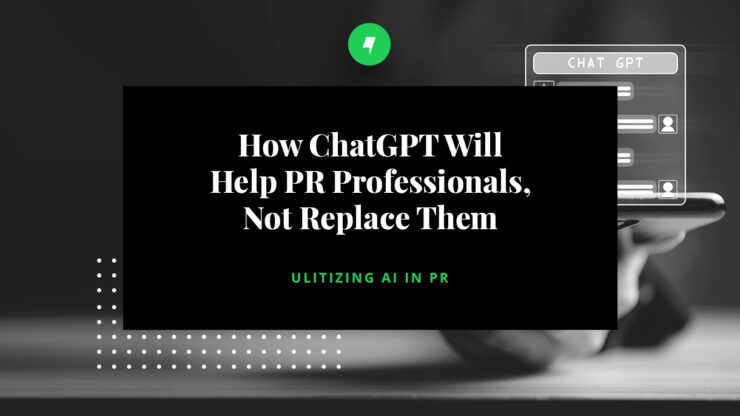By now, you’ve probably heard of ChatGPT, an artificial intelligence (AI) chatbot that can generate human-like content. The chatbot can help answer complex questions and assist with an array of tasks, from composing essays for school, to writing tweets for a client, to providing a run of show for your child’s 10th birthday party. The options are almost endless in what ChatGPT can do in terms of generating content.
Given that ChatGPT can do all these things, many whose occupation involves writing are beginning to wonder what this means for them. Public relation professionals write content every day, and ChatGPT can churn out most content in seconds. So, what are the implications of ChatGPT for PR? I choose to see ChatGPT as a helpful tool for public relations professionals, not an end to the profession.
Jump Starting Creativity
Once you start using ChatGPT, you will begin to see how much time it could potentially save in researching industries, delivering ideas, and producing rough drafts including press releases, pitches, and social media content.
Specifically, ChatGPT can save a lot of time on research for specific topics or journalists who cover specific topics. When I typed in: “give me the top ten journalists writing about commercial real estate,” ChatGPT generated the following:
- Peter Grant, Senior Reporter at The Wall Street Journal
- B. Solomont, Senior National Editor at The Real Deal
- Mark Heschmeyer, Senior News Editor at CoStar News
- Sarah Mulholland, Reporter at Bloomberg News
- Konrad Putzier, Reporter at The Real Deal
- Alexei Barrionuevo, National Real Estate Editor at The New York Times
- Bendix Anderson, Senior News Editor at National Real Estate Investor
- Hiten Samtani, Executive Editor at The Real Deal
- Candace Taylor, Reporter at The Wall Street Journal
- Andrea V. Brambila, Senior Writer at Inman News
While this is a great start for journalist research, it’s just the first step. Specifically, it’s important to double check the topic these reporters cover and the industry, as well as what they’ve covered in the past. After I did a little further digging on this list, I found that Sarah Mulholland now works at Colorado Public Radio, Konrad Putzier now works at the Wall Street Journal, Alexei Barrionuevo works at Billboard not even covering real estate, and Bendix Anderson is a freelancer. Again, ChatGPT provided a nice starting point, but there was still more research that needed to be done.
How Does Written Content Perform
Another use that is very beneficial for public relation practitioners is ChatGPT’s ability to generate press releases, media pitches or social content. All you need to do is enter the appropriate parameters such as the company, industry, tone, location, announcement, news angle, target audience, etc. Once you’ve done that, ChatGPT will generate a release or pitch in seconds. Like the reporter research, additional fact-checking needs to happen. In addition, the current releases template is very basic and comes across like an AI tool wrote it but provides at least a nice place to start.
Here is an example of a tweet I asked it to write: “write a tweet for a grand opening in Philadelphia, PA focusing on affordable housing statistics.”
Here is what it generated: “Exciting news! Join us for the grand opening of our affordable housing development in Philly, where we’re proud to say we’ve increased access to safe, quality housing for low-income families by 25%. Let’s continue to make affordable housing a reality for all. #PhillyHousing #AffordableHomes #CommunityImpact”
The tweet that ChatGPT created is a good place to start, but is a little too generic and needs information including company, location, fact-checking for the statistic, and an adjustment to tone/voice for the appropriate client. But again, a good start.
The Limitations of ChatGPT
Once you start using ChatGPT and becoming familiar with it, you will realize that while it goes generate quickly, there is a lot of room for improvement. Here are the top limitations:
- Generic content – ChatGPT is great at answering questions and drafting rough content but still requires further research and development. Whether it is asking the chatbot to list the top journalists in a certain field or having it write a release, it still requires legwork by the public relations professional to deliver a final product.
- Nuances – I would not want to use ChatGPT in any crisis communications. We do not have to look any further than Vanderbilt University using the chatbot to write an email response to students on the Michigan State shootings. ChatGPT really lacks any emotional intelligence which is not surprising given it is not a human.
- Ethics/Reputation – If a company or organization were to skip the fact-checking steps and just publish what ChatGPT wrote, there could be major ramifications depending on the industry.
- Inaccurate – I will keep hammering at this point, and ChatGPT will tell you itself to make sure to fact-check. It has a limited understanding of human emotions and inability to handle complex issues.
A Tool for Public Relations, Not Replacement
The artificial chatbot is impressive in how quick it can pump out content and some might think that is all they need. However, as you can see, ChatGPT still has a lot of limitations which is why it’s a great tool for public relation practitioners, not a replacement. The chatbot has many beneficial uses and can help anyone formulate ideas, create rough content, and help with research.
Posted In Public Relations
